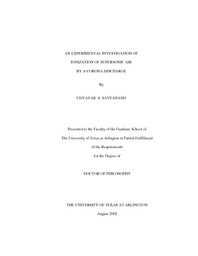
ATTENTION: The works hosted here are being migrated to a new repository that will consolidate resources, improve discoverability, and better show UTA's research impact on the global community. We will update authors as the migration progresses. Please see MavMatrix for more information.
Show simple item record
| dc.contributor.author | Satyanand, Udyavar S. | en_US |
| dc.date.accessioned | 2007-08-23T01:56:29Z | |
| dc.date.available | 2007-08-23T01:56:29Z | |
| dc.date.issued | 2007-08-23T01:56:29Z | |
| dc.date.submitted | August 2005 | en_US |
| dc.identifier.other | DISS-1030 | en_US |
| dc.identifier.uri | http://hdl.handle.net/10106/325 | |
| dc.description.abstract | A technique is developed to ionize supersonic air flow in a shock tube by a weak corona discharge. The driven section of the tube is open to the atmosphere. The shock propagates in the driven section at about 1 km/s by means of an area contraction near the downstream end of the driven section. Air is ionized by a unipolar corona discharge device comprising of a sharp-edged wedge as a high-field electrode inserted in a 41.25 mm (2 in.) ID tube that forms a low-field electrode. The device requires less than 0.5 W. A ring probe, downstream of the corona discharge device, collects charges (ions and electrons) from the air; its output voltage is thus a measure of the degree of ionization. The degree of ionization is varied by varying the corona discharge voltage and the flow speed.
Corona generation was initially demonstrated with bench tests. These indicated an increased degree of ionization with an air flow created by a fan, relative to that in static air. Tests in a shock tube, with subsonic and supersonic air flow, and with a negative corona, provided results with the same ionization behavior. The operating range of discharge voltages is relatively small for a positive corona; hence, shock tube tests were confined to a negative corona.
Shock tube test results indicate that, on a 10 millisecond time scale, corona generated ionization was convected downstream to the probe location in a supersonic flow. An anomalous shock tube result is a probe signal, without a corona discharge, that is similar, but weaker, to the signal with a discharge.
Although the tests were done with shock speeds up to about 1 km/s and with atmospheric air ahead of shock wave, the technique of ionization and plasma measurement can be extended to higher speeds and lower pressures. It is also suggested that a supersonic wind tunnel with a Langmuir probe be used for this type of work. | en_US |
| dc.description.sponsorship | Lu, Frank | en_US |
| dc.language.iso | EN | en_US |
| dc.publisher | Aerospace Engineering | en_US |
| dc.title | An Experimental Investigation Of Ionization Of Supersonic Air By A Corona Discharge | en_US |
| dc.type | Ph.D. | en_US |
| dc.contributor.committeeChair | Lu, Frank | en_US |
| dc.degree.department | Aerospace Engineering | en_US |
| dc.degree.discipline | Aerospace Engineering | en_US |
| dc.degree.grantor | University of Texas at Arlington | en_US |
| dc.degree.level | doctoral | en_US |
| dc.degree.name | Ph.D. | en_US |
| dc.identifier.externalLink | https://www.uta.edu/ra/real/editprofile.php?onlyview=1&pid=274 | |
| dc.identifier.externalLinkDescription | Link to Research Profiles | |
Files in this item
- Name:
- umi-uta-1030.pdf
- Size:
- 2.524Mb
- Format:
- PDF
This item appears in the following Collection(s)
Show simple item record


